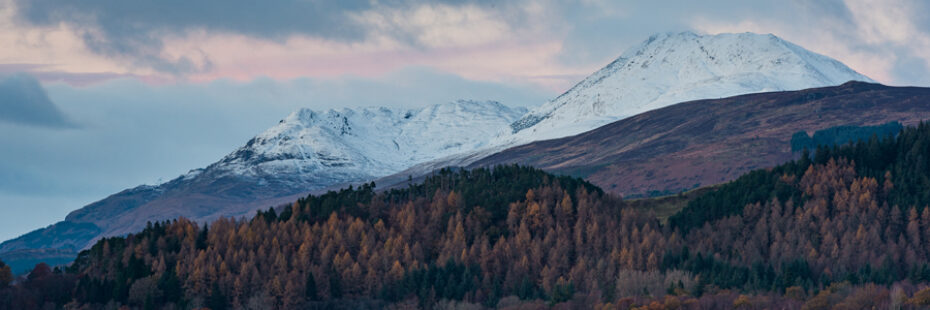
Ben Lomond (974m)
Situated on the eastern shore of Loch Lomond and at the gateway to the Highlands, Ben Lomond’s claim to fame is that it’s the most southerly of the Munros (Scottish mountains with a summit of more than 3,000ft or 914.4m).
The north Loch Lomond area is characterised by a vast and open sense of place and long dramatic vistas. The forests and woodlands along the loch shores contrast with the surrounding uplands to create a landscape of high scenic value. In this context, Ben Lomond provides a dramatic backdrop to the loch and is a landmark summit, being visible from outside the National Park, from as far away as the south of the Clyde river, as well as dominating the Leven Valley.
Its surrounding areas are largely undeveloped and have an open and wild sense of place. From its slopes you can admire a large area of Atlantic oak woodland that surrounds much of the loch and covers many of its islands. Most of this woodland supports a rich and varied lower plant community. The uplands are also of high importance for a range of montane and upland plant communities and associated invertebrates. Ben Lomond and Ben Vorlich across the loch are both designated as SSSIs (Sites of Special Scientific Interest) with species that include black grouse, ptarmigan, upland waders, eagle, pine marten, red deer, mountain hare and water vole.
The peak rises to 974m and the views from the trig point at the summit are truly spectacular. Whether you choose to walk up and down on the well-laid “tourist” trail or a circuit via Ptarmigan Ridge, make sure you stop every so often to look out over the landscape.
It’s clear to see where the Highland Fault Line crosses the park, giving way to lowlands scenery to the south and Highlands to the north.
You can find information about Ben Lomond from the National Trust for Scotland.

Ben Lomond
Before you go…
You’ll often find yourself in locations such as working farms, estates and areas protected for their conservation value, and we hope all our visitors will act responsibly and respect their surroundings, while having a safe and enjoyable time in the National Park.
- Always ensure you are prepared; information and practical advice on how to stay safe can be found by reading about Safety and skills in the mountains from Mountaineering Scotland and on our ‘Respect Your Park & stay safe‘ page.
- Be aware that the owners of the land you are crossing might be engaged in deer management and other farming activities and you can help minimise the chance of disturbance. Read more about it in the Heading to the Hills practical guide.
Loch Lomond & The Trossachs National Park Authority cannot be held responsible for any accidents, injuries or damage sustained whilst hiking in the Park. All persons taking part in such activities do so at their own risk, acknowledging and accepting the risk of accident, injury or damage.

